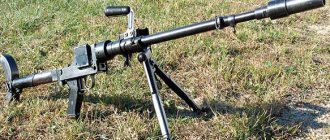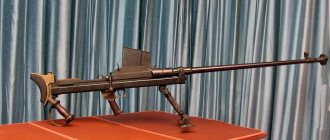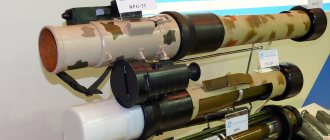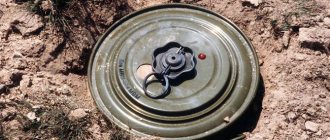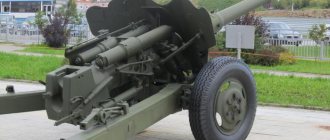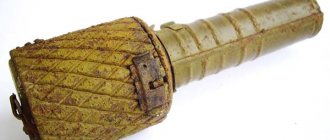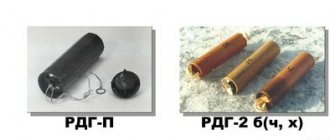"Father" of all RPGs
The American Bazooka anti-tank grenade launcher (M1) is undoubtedly one of the most famous weapons of the Second World War. Despite the primitiveness of its design, it turned out to be a very effective anti-tank weapon and became a role model for the enemy - the German Panzerschreck was created “based on” the captured Bazooka.
The creation of the RPG became possible thanks to the combination of two technologies that had been developed by the early 40s: a shaped charge and a solid propellant rocket engine. In January 1941, the M9 rifle cumulative grenade was adopted by the American infantry. Fired from a standard Springfield M1903 rifle equipped with a special attachment, it could penetrate armor up to 32 mm thick. In November of the same year, the more powerful M10 grenade appeared - it penetrated 50 mm of armor, but was too heavy to fire from a rifle. At first, the Americans tried to transform the grenade from a rifle grenade into a “machine gun” one, firing from a 12.7 mm M2NV machine gun, but the recoil turned out to be excessive for it too. In addition, engineers experimented with the British 13.97 mm Boyce anti-tank rifle and a special 15.24 mm anti-tank rifle, but in both cases, firing an M10 grenade risked damage to the weapon and injury to the shooter. A way out of the situation was found by Colonel Leslie Skinner, who had been working on missile shells for various purposes at the Aberdeen Proving Ground since the early 1930s. He proposed equipping the M10 grenade with a powder rocket engine - thanks to this, the problem of recoil was completely eliminated.
Captain E. Yul with a prototype of the T1 grenade launcher Source: Rottman GL The Bazooka. – Oxford, 2012
The rocket-propelled grenade was launched from an extremely simple, even primitive, 60 mm tubular launcher, which was designed by Skinner’s assistant, Captain Edward Yule. On May 19, 1942, it received an order for 5,000 grenade launchers and 25,000 cumulative rocket-propelled grenades, and on June 24, the first batch of new weapons was ready. The grenade launcher was adopted under the simple designation M1 Antitank Rocket Launcher (“anti-tank missile launcher”), and the grenade for it received the index M6. Among the troops, the M1 quickly acquired the nickname “bazooka” - due to its external resemblance to a wind instrument invented by the then famous comedian Bob Burns.
Bob Burns with his bazooka and a US Army officer with an M1 RPG Source: Rottman GL The Bazooka. – Oxford, 2012
Design
The M1 grenade launcher is a thin-walled steel tube, open at both ends. All other parts of the weapon are attached to it: sights, front grip, pistol grip, shoulder rest, contact safety mechanism and wire guard at the rear end of the barrel. The trigger mechanism is electric, powered by a battery installed inside a wooden shoulder rest (there was a second socket next to it for a spare battery). On the left side of the shoulder rest there is a control light, which, when the trigger is pressed, indicates that the battery and electrical circuit are working properly. One of the battery poles was connected to the “ground” (weapon barrel), the second - to the contact ring of the grenade (through the trigger and contact-safety mechanisms). The contact safety mechanism was located in a small box on top of the rear of the barrel, and consisted of a contact rod connected to the safety lever. Having delivered the grenade into the barrel, the loader moved the lever up, and the contact rod, accordingly, moved down, coming into contact with the contact ring of the grenade. When the trigger was pressed, the contact plates closed and current was supplied to the circuit, igniting the propellant charge of the rocket engine. After the grenade left the barrel, the contact rod moved to the upper position under the action of a spring - the weapon was put on safety. At the rear end of the barrel there was a latch that held the charged grenade and ensured contact of the launcher’s “mass” with one of the poles of the grenade’s electric fuse.
The M1 sights consisted of a rear sight and a front sight and ensured ease of use of the weapon by both right-handed and left-handed people. To do this, the shoulder with the whole was made rotatable (it could be thrown over to the right or left side of the barrel), and frames with front sights located on the right and left were installed at the front section of the barrel. Sights provided shooting at a range of up to 200 yards (183 m).
The M6 rocket-propelled grenade consisted of a cumulative warhead and a powder rocket engine. The impact fuse was located between the warhead and the engine. Due to the relatively low speed of the grenade's flight, it was very sensitive, so it was equipped with a transport fuse - a pin removed by the loader before placing the grenade in the barrel. Six stabilizing feathers were installed on the body of the powder engine (when the grenade was loaded, they protruded beyond the rear section of the barrel). Each feather had a cutout for a retainer. One of the engine electric igniter wires was connected to the stabilizer feather, and through it to the “ground” of the launcher, the other to the contact ring on the ballistic cap of the grenade and, accordingly, to the rod of the contact safety mechanism.
Modifications
The M1 grenade launcher turned out to be an easy-to-use and inexpensive weapon, which contributed to its mass production - the American industry produced 112,790 of these grenade launchers. At the same time, it was not without its shortcomings, the main one being frequent failures of the trigger mechanism. In an effort to reduce the number of misfires, the designers resorted to further simplifying the grenade launcher design. They abandoned the contact-safety device, replacing it with a clip isolated from the barrel with spring-loaded contacts. In addition, the front handle was eliminated and the sights were changed - now they provided fire only from the right shoulder (the rear sight was not reversible, but fixed). The front sight was calibrated for shooting at 100, 200 and 300 yards. Finally, to protect the shooter from the effects of powder gases, a small round mesh shield was installed at the front end of the barrel. This version of the grenade launcher was adopted under the designation M1A1, but its production volume turned out to be almost half that of the first model - 59,932 units.
1/2
Heading1
Heading2
RPG M1A1 device: 1 – barrel; 2 – electrical wire; 3 – rear sight; 4 – metal plate that protects the grenade launcher’s face from burns; 5 – rear part of the barrel, reinforced by wire winding; 6 – contact clip; 7 – gun belt; 8 – battery spring; 9 – battery compartment cover; 10 – batteries; 11 – butt; 12 – spare batteries; 13 – signal light; 14 – fixed contact; 15 – moving contact regulator; 16 – moving contact; 17 – trigger; 18 – front sight; 19 – mesh protective shield Source: Rottman GL The Bazooka. – Oxford, 2012
M1A1 RPG crews training at Fort Benning, September 1943 Source: Rottman GL The Bazooka. – Oxford, 2012
A deeper modernization of the bazooka was the M9 grenade launcher, which appeared in October 1943. It received a longer barrel (1500 mm instead of 1380), which made it possible to abandon the front mesh shield: now the propellant charge of the rocket engine burned completely in the barrel. To make it easier to transport long weapons, they were made collapsible. The rear part of the barrel with a wire cut fence, a clip with contacts and a grenade retainer was designed to correspond to the M1A1 grenade launcher. The trigger mechanism was radically changed, instead of a battery using an electromagnetic generator (“magneto”) as a current source, which was triggered when the trigger was pressed. In June 1944, production of the M9A1 variant began, featuring an improved device for connecting the front and rear parts of the barrel, a reinforced rear part of the barrel tube (wrapped with wire), and also (from September 1944) an optical sight. A total of 26,087 M9 grenade launchers and 277,819 M9A1 grenade launchers were produced.
An illustration clearly showing the difference in the design of the M1A1 and M9 RPGs Source: Rottman GL The Bazooka. – Oxford, 2012
The latest version of the “bazooka” was the M18 grenade launcher, the barrel of which was made of aluminum alloy. Thanks to this, the weight of the weapon decreased by a third compared to the M9A1 - from 7.2 to 4.8 kg. The M18 was put into service in April 1945, but after production of five hundred copies production was stopped - the war was coming to an end. Nevertheless, the M18s managed to see war - 350 units were sent to the Philippines and Okinawa for testing in combat conditions.
In parallel with the improvement of the grenade launcher, ammunition also evolved. The M6A1 and M6A2 grenades had a modified electric fuse design (adapted for the M1A1 and M9 grenade launchers) and a modified tail unit. The M6A3 grenade received a hemispherical ballistic tip instead of a conical one, as well as an improved M400 fuse with an additional fuse (a spring that blocked the firing pin and released it after the grenade exited the barrel). The M6A3 warhead contained 230 g of pentolite, and the rocket engine was loaded with 65 g of gunpowder. The armor penetration of the M6A3 has increased to 100 mm (for previous modifications of grenades it was 75 mm). For training purposes, M7, M7A1, M7A2 and M7A3 grenades were used, which fully corresponded to combat ones in terms of weight and size parameters, but with inert warheads. The ammunition load of the M9 (M9A1) grenade launcher also included an M10 incendiary-smoke grenade, equipped with 400 g of white phosphorus - in addition to creating smoke in the area, it could be used to destroy manpower in premises and field fortifications. The total production volume of cumulative grenades amounted to 12,996,000 units, incendiary-smoke grenades - 2,607,000 units.
Combat debut
Most of the first batch of M1 grenade launchers was sent to US allies who were in dire need of anti-tank weapons. Great Britain received 600 units in September 1942. The grenade launchers were delivered to Suez, tested and... sent to a warehouse. The British military considered that in the open terrain of the North African desert the chances of a grenade launcher getting within 200 yards of an enemy tank were negligible. Britain later received another 1,500 bazookas, transferring them to the French Resistance.
Another 3,000 M1 grenade launchers and 8,500 grenades for them arrived in the USSR. And in this case, the test results turned out to be unsatisfactory: the Soviet side noted the low armor penetration of the grenade launcher (50–55 mm - one third lower than stated in the American specification), low firing accuracy at a distance exceeding 50 m, flames and smoke that unmasked the firing position , instability of combustion of powder grenade charges at low air temperatures. As a result, the USSR refused further deliveries of bazookas, and Soviet armor-piercing soldiers continued to fight with 14.5-mm PTRD and PTRS anti-tank rifles, which were more bulky than the bazooka and had worse armor-piercing qualities.
During World War II, bazookas were also supplied to the troops of Free France (11,350 units plus 2,616 grenade launchers transferred to the Resistance), Brazil (2,876), China (2018) and Canada (177).
Alexander Sirota
/
Hungarian hybrid bazooka and panzerschreck
The history of the creation of the Hungarian anti-tank grenade launcher 44.M
- WWII
- weapon
- Hungary
The US Army first used bazookas during Operation Torch, the landing in North Africa that began on November 8, 1942. It is interesting that by the time the operation began, not a single unit participating in it was yet armed with grenade launchers. At one point, the quartermasters, while sorting out another shipment of cargo delivered from the USA, discovered a box with unfamiliar markings “Launcher, rocket, antitank, 2.36-in, M1.” The word “anti-tank” immediately aroused interest in the contents of the boxes. Having opened one of them, the officers saw six strange pipes. Having rummaged through the received cargo, it was possible to find boxes with M6 grenades, but there were no instructions for using grenade launchers. The latter did not prevent a number of units from starting to use grenade launchers. Already in November 1942, their use was recorded against French units trying to resist.
Most units received the “bazooka” with a significant delay - for example, the motorized infantry of the 1st Armored Division received the first grenade launchers at the end of December 1942, the 34th Infantry Division only on February 13, 1943, on the eve of the German offensive at the Kasserine Pass. Naturally, the fighters did not have time to master the new weapon, and in these battles a number of grenade launchers fell into the hands of the Germans, who assigned the M1 its own designation Raketenpanzerbüsche (R.PzB.) 788(a). It was these trophies that prompted the Germans to develop their own Panzerschreck reusable anti-tank rocket launcher. Its main difference from the American prototype was the caliber increased to 88 mm and better armor penetration characteristics.
"Bazooka" and "Panzerschrek" Source: Rottman GL The Bazooka. – Oxford, 2012
Bazookas were first introduced into American infantry units only in March 1943, several months after their combat debut. Each infantry company received three RPGs, located in the control section of the heavy weapons platoon; there were no regular crews for them. Each infantry squad was required to train two riflemen in the use of grenade launchers, and grenade launchers were issued from the heavy weapons platoon to the infantry platoons if necessary. Another seven RPGs were in the heavy weapons company of the infantry battalion and eight in the headquarters company. Thus, the infantry battalion had 24 grenade launchers, the regiment (including regimental units) - 93. In February 1944, the number of bazookas in the infantry company was increased to eight, but there were still no regular crews for them.
To service the bazooka, a crew of two people was required Source: Rottman GL The Bazooka. – Oxford, 2012
The parachute companies, which were the first to receive M9 grenade launchers (the long M1 and M1A1 proved to be inconvenient for paratroopers), had four RPGs as of February 1944 - one in the company control and each of the platoons. In practice, commanders of parachute companies often concentrated all four bazooka crews under their direct leadership. In the glider airborne companies the number of RPGs was large - 5-6 units each. Probably the first case of allocation of regular crews for bazookas was the ranger units, in each platoon of which one RPG crew was introduced. In infantry units, regular RPG crews appeared only in 1948, when a heavy weapons department was introduced into infantry platoons, which included a heavy machine gun crew and an RPG crew (four people - a grenade launcher, a loader and two ammunition carriers).
Soldiers of the 17th Airborne Division with an M9 RPG. France, January 1945 Source: Rottman GL The Bazooka. – Oxford, 2012
A significant number of “bazookas” were also available in other units - for example, each division of 105-mm or 155-mm howitzers from the artillery of an infantry division, according to the states of March 1943, received 40 RPGs.
The use of “bazookas” in the Marine Corps had its own specifics - during landing operations in the Pacific Ocean, the main targets of grenade launchers were not tanks, of which the Japanese had relatively few, but various field fortification objects. Grenade launchers were concentrated at the battalion level - as part of assault platoons. Such a platoon included three sections of two sections, each section consisting of seven people: a commander, a grenade launcher crew (two people), a flamethrower crew (two people) and two demolition engineers.
"Bazookas" on European fronts
By the time Operation Husky began (landing in Sicily in July 1943), RPGs had already been sufficiently mastered by the personnel of American units. It was thanks to the bazookas that the Americans managed to repel counterattacks of German and Italian tanks on the Gela bridgehead. But real recognition for grenade launchers came after Operation Shingle, the landing in mainland Italy that began on September 9, 1943. At Salerno, the landing troops almost immediately came under heavy attack from the German 16th Panzer Division, but thanks to the skillful use of artillery and anti-tank weapons, the Americans were able to defend the bridgehead. After these battles, the bazookas gained a reputation as an “excellent defensive weapon.”
.
Due to its large length, the M1A1 grenade launcher was inconvenient for paratroopers Source: Rottman GL The Bazooka. – Oxford, 2012
When the Normandy landings began in June 1944, the US Army was still dominated by the older M1 and M1A1 RPGs. Even paratroopers parachuted with these inconveniently long tubes, and the more practical folding M9 RPGs received a baptism of fire during the landings in Southern France in August 1944.
Grenade launcher with M9 RPG Source: Rottman GL The Bazooka. – Oxford, 2012
The “Bazooka”, created in the era generated by the German blitzkrieg, was massively used in completely different conditions. In Normandy and the south of France in the summer of 1944, the Wehrmacht did not have large tank formations, so the main task of the grenade launchers was to defeat German firing points - and the bazookas coped with it very successfully. Therefore, when M9A1 grenade launchers began to arrive en masse in units in the second half of 1944, commanders often did not return the old M1A1 to warehouses. As a result, the number of RPGs exceeded the required number - the infantry battalion often had 40 or more bazookas.
Members of the assault team of the 2nd Ranger Battalion with an M1A1 grenade launcher aboard a landing craft on the eve of the Normandy landings Source: Rottman GL The Bazooka. – Oxford, 2012
In Normandy, the first American encounter with a significant number of enemy tanks occurred on July 11, 1944, near the Vir River. The attack by the German Tank Training Division was repulsed mainly due to the successful actions of M10 tank destroyers. As for the bazookas, they turned out to be powerless against the frontal armor of the Panthers and medium tanks PzKpfw IV Ausf H/J. The next major tank attack against the Americans was launched on the night of August 6-7 at Mortain - it involved 120 tanks and 32 self-propelled guns. The main role in repelling it was played by 76.2 mm anti-tank guns and field artillery, and the contribution of RPG crews to the victory was minimal. For example, the 30th Infantry Division claimed the destruction of 69 German tanks, of which only ten were bazookas. Successful destruction of tanks by grenade launcher fire was only possible if they hit the side or stern. However, the characteristic landscape of Normandy - bocage (fields interspersed with forest plantations and hedges) - often contributed to this.
The number of bazookas in American troops operating in Western Europe was constantly growing: if in June 1944 it was about 35,000, then by the end of April 1945 it exceeded 93,000 units. The consumption of ammunition for bazookas during the periods of the most intense fighting (December 1944-February 1945) was about 200,000 rounds per month. And although the first generation RPGs had a number of shortcomings, this did not stop General Dwight Eisenhower from answering the question of which types of weapons, in his opinion, contributed most to victory: “The Bazooka, the Jeep, the atomic bomb and the C-47 [transport aircraft].”
.
Tactical and technical characteristics of 60-mm anti-tank rocket launchers
| M1 | М1А1 | M9, M9A1 | M18 | |
| Length in firing position, mm | 1372 | 1389 | 1550 | 1538 |
| Length in stowed position, mm | 1372 | 1389 | 800 | 800 |
| Weight, kg | 5,94 | 5,99 | 7,2 | 4,67 |
| Maximum firing range, m | 640 | |||
| Effective firing range, m | 275 | |||
| Rate of fire, rds/min | 4–5 | 4–5 | 10 | 10 |
Literature:
- The evolution of the organization of the US infantry division on the eve and during the Second World War // Arsenal-collection. – 2013. – No. 6
- Kupidura P. Granatniki przeciwpancerne M1, M9 // Nowa techika wojskowa. – 2004. – No. 9
- Rottman G.L. The Bazooka. – Oxford, 2012
- Zaloga SJ Bazooka vs Panzer. Battle of the Bulge 1944. – Oxford, 2016
Anti-tank grenade launcher PIAT / PIAT (UK)
Anti-tank grenade launcher PIAT / PIAT
Anti-tank grenade launcher PIAT / PIAT loaded
armor-piercing cumulative grenade for the PIAT / PIAT grenade launcher
Anti-tank grenade launcher PIAT / PIAT in action
| Caliber | 83 mm |
| Type | — |
| Length | 990 mm |
| Weight (empty) | 14.5 kg |
| Effective range | ~100 meters |
| Armor penetration | 75-100 mm |
The PIAT anti-tank grenade launcher (Projector, Infantry, Anti-Tank - literally “infantry anti-tank launcher”) was developed in Great Britain in the early period of the Second World War by Major Jefferis on the basis of the experimental Blackerbombard. Since 1943, the PIAT anti-tank grenade launcher, produced by the English company Imperial Chemical Industries, was massively supplied to the troops of Great Britain and the countries of the British Commonwealth, where it was successfully used to combat German armored vehicles and field fortifications. The PIAT grenade launcher was also supplied to the USSR. Compared with contemporary systems (American Bazooka, German Offenror), the PIAT grenade launcher had both positive aspects (the absence of a dangerous missile exhaust zone, which made it possible to shoot from indoors and shelters, a low unmasking effect of the shot) and negative ones (a large mass of the weapon and strong, painful recoil when shooting).
The PIAT anti-tank grenade launcher uses an original launch scheme, in which the “barrel” is the hollow tubular shank of the launched grenade. Before firing, the grenade is placed in an open tray in front of the grenade launcher. After pressing the trigger, a very massive firing pin rushes forward, while a long rod located in its front part penetrates deeply into the shank of the grenade until the front part of the firing pin pricks the primer of the expelling cartridge, located in the front part of the tail tube of the grenade, immediately behind the combat part. Powder gases from the cartridge push the grenade forward while simultaneously pushing the firing pin back. In this case, a grenade weighing about 1.2 kg leaves the grenade launcher at a speed of about 80 m/s, and the massive firing pin, under the influence of recoil, cocks its mainspring and is automatically cocked. To manually cock the firing pin (before the first shot or after a misfire), the shooter had to rest both feet on the shoulder rest located in the rear of the tubular body of the grenade launcher, and, grabbing the large trigger guard, sharply pull the weapon body towards himself. In this case, the shoulder rest, connected by a rod to the firing pin, was pulled out from the body, cocking the firing pin. This procedure required considerable effort.
The main type of grenade for the PIAT / PIAT grenade launchers were cumulative anti-tank grenades with aerodynamic stabilization using a fixed tail. For training, grenades with inert warhead filling were used.
The grenade launcher itself consisted of a tubular metal body, to which a grenade launcher was attached at the front, and fire control handles and a trigger mechanism at the bottom. Inside the case there was a powerful mainspring and a massive firing pin. The sights had the form of a front sight and a diopter rear sight with two or three apertures for ranges of 50, 80 and 110 or 70 and 100 yards. For firing from a rest, the PIAT grenade launcher was equipped with a folding bipod-support in the form of the letter “A” or “inverted T”. A rubber recoil absorber was usually attached to the butt plate of the shoulder rest.
New anti-tank weapons with new capabilities
Modern weapons, created on the basis of the latest achievements of science and technology, have high combat, operational and technical properties. But no matter what kind of weapon it is, no matter how high its combat properties, the result of its use is always determined by man. That is why the constant concern of weapons developers is not only the creation of advanced weapons, but also new training tools.
Some new models of Russian grenade launcher weapons and shooting training equipment were first presented in 2008 at the annual meeting of the leadership of the combat training departments of the branches and branches of the military, military districts and fleets of the Russian Armed Forces.
Promising grenade launchers
At the presentation held by specialists from the Federal State Unitary Enterprise “State Scientific and Production Enterprise “Basalt” at the Training Center in the village.
Alabino was presented with modern samples and the latest developments of this enterprise in the field of grenade launchers. Deputy Head of the Military Training Directorate of the RF Ministry of Defense, Major General I.A.
Buvaltsev at the presentation of the latest developments of the Federal State Unitary Enterprise "State Research and Production Enterprise "Basalt" at the Training Center in the village of Alabino. First of all, this is a multi-purpose multi-caliber grenade launcher system RPG-32. Its peculiarity is that the reusable launch device with an automated sight has insignificant weight (3 kg) and dimensions (length 360 mm). Before firing, depending on the task being performed, a container with the selected type of shot of 72 or 105 mm caliber with a grenade in cumulative or thermobaric armor-piercing ammunition is docked to it. The total mass of the grenade launcher system, depending on the type of shot selected, is 6–10 kg, and its length is 900–1200 mm. This design solution provides a rational combination of the grenade launcher’s overall combat load and portable ammunition with the tasks being solved and the types of targets being hit.
The new grenade launcher has significant capabilities. The aimed firing range is 700 m. The destructive effect of a 105 mm cumulative grenade, penetrating at least 650 mm of homogeneous armor (after overcoming dynamic protection), ensures effective destruction of the latest and future tanks. 72 mm rounds with cumulative grenades are capable of defeating all medium and lightly protected armored vehicles. Shots of both calibers with thermobaric equipment at the head of the grenade make it possible to effectively combat lightly armored and unarmored vehicles, covert and open enemy personnel, as well as hit various fortifications and concrete shelters.
The RPG-32 grenade launcher has high ergonomics, which ensures ease of use from various positions, speed and accuracy of aiming the weapon at the target, and ease of loading. In the stowed position, the sighting device and elements of the electric firing mechanism are placed in the trigger device. It is possible to equip the grenade launcher with a night sight.
Demonstration of the new RPG-32 “Hashim” grenade launcher
According to experts, the RPG-32 is today the most advanced grenade launcher system in the world and has the best combat and operational properties.
Another new product demonstrated during the presentation was a modernized version of the famous RPG-29 Vampire grenade launcher system. The new modification of the RPG-29 is installed on a tripod machine with guidance mechanisms and is equipped with an automated fire control system with day and night sights and a laser rangefinder, allowing automatic consideration of shooting conditions. Just as when firing from the RPG-29, the new modification uses shots with tandem and thermobaric fragmentation-armor-piercing warheads. The grenade launcher system ensures effective destruction of various (including heavily armored) targets at a distance of up to 700 m.
In the class of disposable grenade launchers, both the highly acclaimed RPG-26 and RPG-27 rocket-propelled anti-tank grenades and the RShG-1 and RShG-2 rocket-propelled assault grenades created on their basis, as well as new items - RPG-28 and RPG-30, were presented.
New learning opportunities
The effectiveness of the use of even the most modern weapons depends entirely on the level of training of the human operator of the weapon and its commanders. For this purpose, combat and psychological training is carried out in all armies of the world. Its effectiveness largely depends on the teaching tools used.
Family of rocket-propelled grenades developed by FSUE State Research and Production Enterprise Basalt: RPG-26, RShG-2 and PUI-26 for shooting training
Today, it is customary to refer to a wide arsenal of a wide variety of devices as teaching aids. The creation of new teaching aids with high didactic capabilities has long been the subject of special attention and an integral part of the work of the creators of new weapons and military equipment. The training tools are designed to facilitate and speed up the development of weapons objects, their combat use and operation. At the initial training stage, they can significantly reduce the use of expensive weapons and ammunition.
A set of such training tools for firing anti-tank grenade launchers was created in Russia. These include devices for training and simulation shooting, electronic simulators, laser shooting and hitting simulators.
The conditions for the combat use of hand-held anti-tank grenade launchers and their capabilities determine the need to fire at a short range of about 50-300 m, that is, when the enemy can have a real and significant fire impact on the grenade launcher. In other words, all the activities of grenade launchers take place under conditions of combat stress. In addition, the loud sound of the shot, the flame jet or the countermass material behind the grenade launcher also create certain dangerous effects on the shooter and others when fired. That is why the high efficiency of using rocket-propelled grenade launchers is ensured by a high level of comprehensive training of the shooters.
The latest developments of rocket-propelled anti-tank grenades RPG-27, RPG-30 and RPG-28 are considered by some to be an asymmetric threat to US security
For a long time, many armies around the world used devices with an insert barrel for firing a bullet to train in firing grenade launchers.
In the USSR and Russia, shooting training devices were used for these purposes - PUS-7 (for RPG-7), PUS-9 (for SPG-9) and PUS-29 (for RPG-29). They were fired with cartridges containing a tracer bullet through a special insert barrel placed in a mock-up grenade. The design provided the bullet with ballistics corresponding to only one firing range, and then without the ability to take into account the characteristic features of the movement of a combat grenade along the trajectory. These devices made it possible, to a certain extent, to instill the necessary skills in grenade launchers. However, the lack of matching trajectories of a bullet and a combat grenade, the characteristic sound of a shot and a gas-flame jet behind the grenade launcher reduced their similarity to live firing from this type of weapon.
In addition to the PUS-type device for shooting training, many armies around the world use shots with an inert filling of the head (combat) part of the grenade. When firing inert grenades, complete alignment of trajectories with grenades in combat equipment is ensured, the same level of shot sound and the formation of a dangerous gas-flame jet behind the grenade launcher. In Russia, all analogues of combat grenades were created in inert ammunition for grenade launchers such as RPG-7V, RPG-29, SPG-9, RPG-18, RPG-22, RPG-26 and RPG-27.
IRG-27V round for firing from PUI-27
The difference between shots in inert ammunition and combat ones lies in the design of the warhead. That is why their cost is slightly less than the cost of combat grenades and is only the difference in the cost of the warheads. In this regard, shots in inert ammunition are intended to be used only at the final stages of training and during control checks of grenade launchers who have completed the training course.
The difficult conditions of combat use of grenade launchers in battle require the grenade launcher to be able to correctly and quickly use his weapon to hit the selected target. Ensuring a high probability of a hit at a targeted shooting range is possible with mandatory consideration of all shooting conditions, and first of all, side wind and flanking movement of the target, i.e. correct application of shooting rules. Such skills are developed only through regular training.
For this purpose, an electronic simulator 9F700 was created in Russia, designed to develop and improve the professional skills of shooters armed with various types of grenade launchers and rocket-propelled infantry flamethrowers. The simulator simulates various conditions of firing from grenade launchers and allows shooters to study and train the application of shooting rules for various targets. In addition, it allows the training leader to objectively monitor the level of training of the shooter-operator during the training process. However, due to its characteristics, the electronic simulator cannot completely replace real shooting from grenade launchers.
RPG-26 shooting training using PUI-26
Another new generation training tool actively used in combat training of troops is laser shooting and killing simulators (LISP). Their main purpose is to improve shooting skills from various types of weapons in a two-way training battle and to simulate the firing of enemy fire weapons. The disadvantage of LISP, as well as electronic simulators, is that they do not reproduce the real sound of a shot and do not create a gas-flame jet behind the grenade launcher, that is, they do not provide conditions for the development of real “combat reflexes”.
In order to eliminate the shortcomings inherent in the listed training tools, specialists from the main developer of grenade launchers in Russia - FSUE SNPP Basalt - created fundamentally new means of simulated shooting. They are called practical educational equipment (PUI). Today, various simulation tools have been created for all modern Russian grenade launchers.
The new training tools are dimensional copies of standard disposable grenade launchers or shots for reusable grenade launchers with an insert barrel and a practical grenade with a jet engine and with an inert warhead of smaller diameter, length and weight than combat grenades. The ballistics of practical imitation grenades and the accuracy of their firing are fully consistent with combat ones at all aimed shooting ranges. This makes it possible to conduct training shooting using the shooting rules for live grenades in all the variety of conditions of their use.
The simulated rocket-propelled grenade has a tracer to monitor its flight and is equipped with a simulator of operation on the target. The relatively high sound level of the shot and the presence of a gas-flame jet when fired provide a high degree of similarity to shots from a live grenade.
Assembling the shot model, loading the grenade model before firing, aiming and firing are carried out similarly to standard models. The design of the imitation grenade allows it to be used to fire at real tanks, infantry fighting vehicles and armored personnel carriers. PUI devices provide multiple uses, their service life is at least 300 shots, while the cost of one shot is 3-4 times lower than an inert one.
The new training tools are designed not only for initial training, but also to improve and maintain the necessary skills in shooting grenade launchers, especially to learn how to properly account for a variety of shooting conditions. PUIs can successfully replace shots in inert ammunition and all types of bullet devices for target practice in the system of training aids.
RPG-29 “Vampire” anti-tank rocket launcher with fire control system
The presence today in the training system of grenade launchers of the Russian Army of various training tools with new capabilities can significantly reduce costs and time for training, while simultaneously increasing the level of their skills and abilities.
Victor Korablin “Review of the Army and Navy” No. 1-2009
